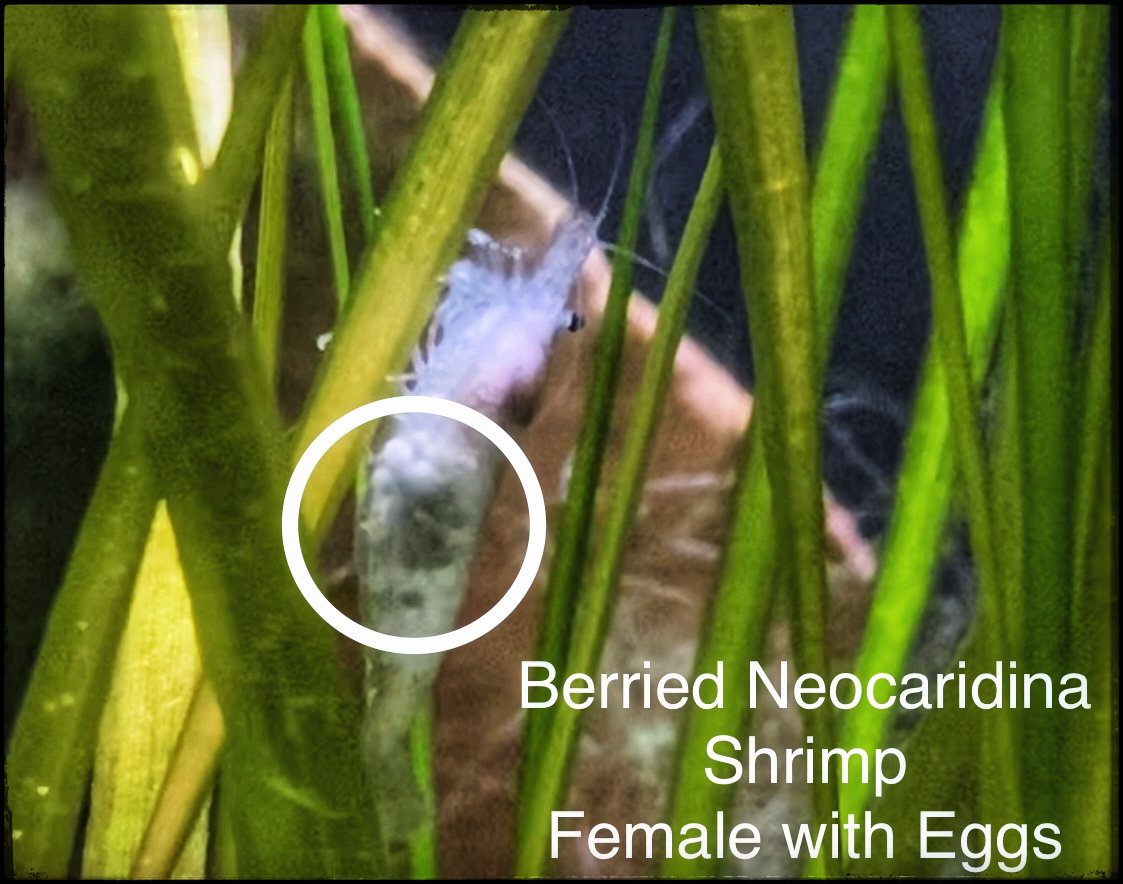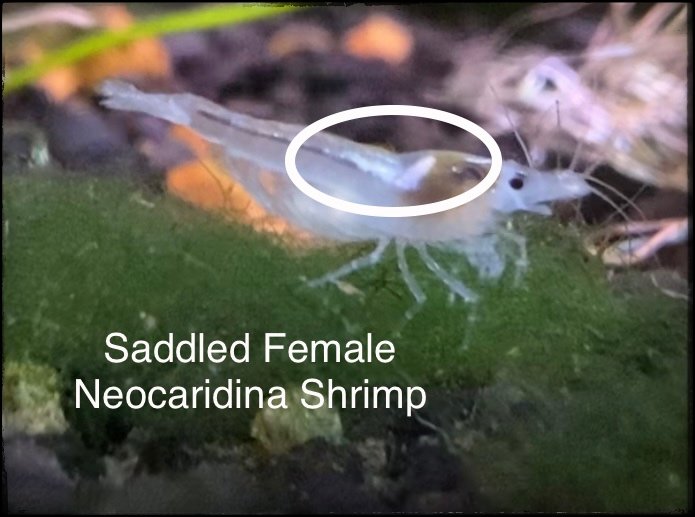Expanded Shrimp Care
Neocaridina Shrimp
Kingdom: Animalia
Phylum: Arthropoda
Class: Malacostraca
Order: Decapoda
Family: Atyidae
Genus: Neocaridina
Species: Neocaridina Shrimp
Care level-Moderate to Advance
Temperament and Behavior- Neocaridina Shrimp are peaceful, calm, adorable additions. They are often found grazing along the aquarium's bottom, their little legs going crazy scavenging for food. Even though they are a bottom dweller, they will hurry through the water column looking for anything to cling to, inspecting for food. The only aggression I have seen is that if there is a weak or dying shrimp, they will occasionally get eaten by another healthy shrimp in the colony.
Lifespan-2 years
Size- 1 inch-1.5 inches
Diet-Neocaridina will graze on biofilm and algae. What is biofilm? Biofilm is the film you see on new driftwood pieces or leaf litter; it looks like a white mold growing on any organic material (carbon-based compound) introduced into the aquarium. This thin biofilm is nutritious to Neocaridina Shrimp, and it is waste from organic matter. This waste is a mix of carbohydrates (sugars) and lipids (fats) that bacteria feed upon this excess organic waste. Neocaridina Shrimp do not seem to be picky eaters. The shrimp in the fish room get fed a variety of foods, with no standout favorites; here are some foods that have been a hit: Fluval Bug Bites Shrimp Formula, Aqueon Shrimp Pellets, Hikari Crab Cusine, and Xtreme Shrimpee Shrimp Food.
Minimum Tank Size- The smallest Neocaridina shrimp tank I have kept is a 5-gallon, and the largest is a 55-gallon. The most critical aspect is consistent water quality no matter the aquarium size.
pH 6.0-8.0
Water Hardness- Hard Water
Temperature- 72-78 Fahrenheit- Increased water temperature will increase the growth rate, boost digestion and metabolism, and decrease lifespan.
Tank-mates- If you want to keep shrimplets in the future and want to keep them with tank-mates, make sure you choose a fish species that is calm and peaceful. Shrimplets make easy delicious food for most fish, and super curious fish will find them and try to have a snack of them. I would choose tank-mates with a small mouth in adulthood so that your Neocaridina Shrimp will not get picked off one by one.
Recommended Group Size- I have kept alone Amino shrimp in a 55-gallon, a couple of Blue Dreams mixed with a handful of Cherry Shrimp in a 10-gallon tank, and a 20L tank full of countless yellow Neocaridina shrimp. I haven't noticed any negatives with owning only one or a whole colony. However, keeping a small group, in the beginning, will help ensure you have both males and females to help with future shrimplets.
Male v. Female- At first glance, it is difficult to tell male vs. female Neocaridina Shrimp apart. Honestly, the easiest way is to see eggs in the belly region of the shrimp in question, and identifying eggs is a tell-tell way of indicating a female. However, when there are no eggs, you're in luck, and there is still an easy way if you look closely.
Male Neocaridina shrimp are usually smaller in stature compared to females. Males are sometimes duller or opaque in color, are straighter bodied, and have no saddle.



Berried vs. Saddled
Female Neocaridina Shrimp are proportionately bigger than males, often brilliantly colored, with a rounder belly and saddled. Indicating a Saddle is another way of identifying a female. A saddle is a spot, upon maturity, located on the top of the body between the head and the shrimp's abdomen. Eggs produced in the shrimp's ovaries form this yellowish area in the female and are kept there till fertilization. When you hear the statement that a female shrimp is "Saddled," this is what it means.
Before any mating can happen, shrimp will molt; at this time, the shell is the softest. Fertilization occurs. The eggs will drop down into her rounder belly; you can usually see the eggs. When you hear someone refer to berried female shrimp, she has dropped fertile eggs into her stomach. The eggs will drop down into her rounder belly; you can usually see the eggs. She will constantly eat with her front legs, and with her back legs, she will fan the eggs to help them continuously move around to prevent fungus. Shrimp have "legs" known as pleopods or swimmerets. Neocaridina Shrimp are crustaceans with five pairs of these "legs" on the underside of their abdomen. Each body segment contains one pair of pleopods/ swimmerets, a fan-like appendage used to propel forward. The back swimmerets (back legs) fan eggs; the first pleopod pair in male shrimps inseminates the female shrimp at the saddle. Females need calcium and protein for eggs.
Shrimplets- When born, shrimplets are a replica of their parents and will fend for themselves. Before hatching, the female shrimp will diligently care for her eggs for about 30 days. They will jump out of the mother and find a mossy spot and won't typically move for the first few days. You will want to feed these freshly born shrimplets so they will not have to search for their food. Shrimplets will reach maturity in about 2-3 months or 75 days. Usually, about 60 days till the juvenile stage adding another 15 days till fully mature. Before each breeding, the female will molt, including the first breeding. I believe male Neocaridina Shrimp molts (sheds) every 2-3 weeks, which is a good sign of healthy growth.
Tank Setup-
Yellow Neocaridina- I keep my yellow Neocaridina Shrimp in a 20Long planted aquarium. This shrimp/ guppy tank has a hang-on-the-back filter modified, full of aquarium media- planted with various plants: guppy grass, a banana plant, and a few stem plants. This shrimp tank does the best, and I see the most shrimplets. However, the shrimp enjoy it with extra algae build-up, leaf litter, and driftwood pieces.
Cherry Red shrimp- are the first shrimp in the fish room that I kept. Today, I have various yellows, reds, black dreams, and wild types from these first few cherry red shrimp. When culling (take out the specific ones I do not like) shrimp tanks, I will put them together with similar colors in a separate aquarium. The culled cherry shrimp go into a ten-gallon Guppy tank. This aquarium has a modified hang on the back filter with no carbon inserts. However, it is instead full of aquarium media and an aquarium sponge. This 10-gallon tank has a substrate mix of Fluval stratum, creek gravel, a couple of medium rocks from the yard stacked, and moss.
Bloody Mary- These are beautiful shrimp, and the fish room is lucky to have Bloody Mary Neocaridina shrimp. These shrimp are incredibly dark red, to the point they almost look black. I cull and separate these shrimps and put them in a heavily planted 55-gallon "Mutt Guppy" tank—this aquarium as a substrate of mostly sand with clamp shop lights and a modified hang-on-the-back filter.
Blue Dreams- Out of all the shrimp in the fish room, the Blue Dream Neocaridina shrimp are the ones I have had the most trouble keeping. I purchased 10-12 Blue Dream Shrimp at the club auction, and along with those, I bought a few more at the local fish store. Slowly, I lost all but two of these Blue Dream Shrimp, and the last two are now in with the Cherry Shrimp 10-gallon tank. The original tank was a 10-gallon Guppy/ snail aquarium with a substrate of crushed coral only with a couple of small driftwood pieces.
Wild Type-I cull usually wild-type Neocaridina shrimp. These are still fun shrimp to keep, and they are not as colorful as the rest but still delightful to watch. I do cull them out and put them in my 30-gallon Swordtail tank and a 5-gallon no-filter Guppy tank. I rotate between these two aquariums when I see a wild type.
Safeguard your shrimp by taking all precautions in the beginning by adding them to a well-maintained, well-balanced tank with good water quality. Don't worry too much. If you do have some algae, Neocaridina shrimp will enjoy it. You will always find shrimp grazing on the algae that will grow on the back glass—also, having rock piles or a gravelly substrate allows the females to be burry down. Shrimp require good water quality to thrive and breed. They need a well-established tank with no fluctuations. Shrimp do not handle changes in water conditions and parameters well. Also, do yourself a favor by adding a few West Indian Almond Leaves or Catappa Leaves to the aquarium before the shrimp arrive. Don't be alarmed if the water darkens in color; these tannins are beneficial. However, if you don't find the tea-colored water appealing, you can boil the leaves before adding them to the tank. Adding Catappa Leaves have beneficial qualities of working like antibacterial and anti-fungal properties. Along with these tremendous benefits, shrimp will use these leaves as a food source, eventually breaking them down to stems that you can remove or not. Adding one last point, I find that all of the Neocaridina Shrimp I have kept benefited from extra oxygen, either a sponge filter or air stone.






